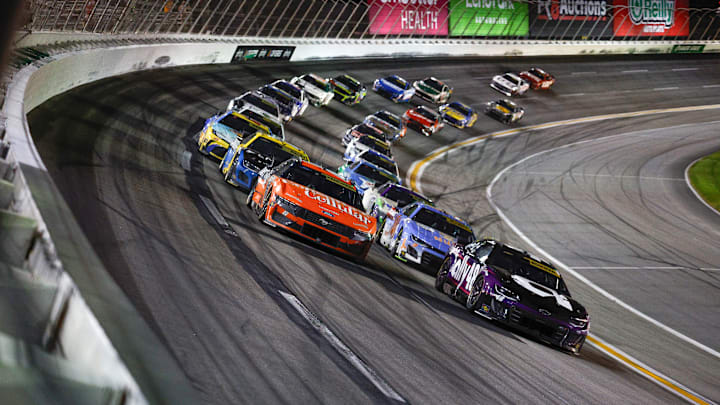The NASCAR fanbase is one that collectively cannot stand "gimmicks". We've known this since long before the playoffs were ever even introduced in 2004, and that became even more abundantly clear in 2014 when the knockout playoff format was implemented.
Now in its 12th season of utilization, the modern playoff format gets more and more scrutiny every year, with last year marking the (current) peak after Joey Logano, who only made the playoffs because of a five-overtime win over the driver who was last in points at the time, won the title following a regular season finish of 15th in the point standings.
NASCAR fans have been calling for changes for years. All NASCAR has done is added further gimmicks, first by adding stages in 2017 and then by taking away the playoff clause that required race winners to be inside the top 30 in the point standings in order for them to actually have their wins lock them into the postseason.
So what better way to stir up the NASCAR fanbase than by adding an in-season tournament?
The tournament, in and of itself, is a gimmick. There is no doubt about it. Having said that, it also doesn't inherently impact the overall racing product like stages and playoffs do, and the five tournament races are also still regular season races.
In the grand scheme of things, they count just as much as any of the other normal 21 regular season races do.
You can technically ignore the tournament, and your season itself would be unaffected.
Some people in the replies are salty about the bracket challenge, so I’m going to gently say this and you can take it for what it’s worth: Instead of spending the next five weeks getting angry at every mention of it and hating it…why not just fill out a bracket and play? It’s…
— Jeff Gluck (@jeff_gluck) June 28, 2025
But NASCAR is well aware of the complaints – and, like it or not, attention – that follow whenever such a change is made or format is implemented. We all see what is said on social media and how many fans just love to pile on the sport whenever something goes wrong, especially if it's caused by an idea that very few people wanted to begin with.
NASCAR's in-season tournament was just begging for those complaints.
By having the tournament opener at Atlanta Motor Speedway, which is now a drafting track rather than a typical mile-and-a-half oval, NASCAR effectively rendered the three seeding races (which also generated plenty of complaints, of course) meaningless, and, above all else, totally random.
Saturday night's Quaker State 400 produced multiple instances of the "Big One" (along with several much smaller incidents).
Drivers who earned high seeds were left helpless, drivers who would have had next to no chance to advance at non-superspeedway track advanced, and some drivers who were involved in wrecks moved on from the round of 32 to the round of 16 while others who weren't collected did not advance.
Sure, that could have happened at any other track. But by having a tournament race at a superspeedway, this kind of outcome was inevitable. There was zero benefit to having seeding races (or really using any form of seeding), as evidenced by the fact that three of the top four seeds were eliminated in the first race.
Driver performance was relative to one other driver, meaning not everybody was playing the same game when determining the tournament results.
And it only gets better.
Next weekend's race is at the sport's only street track in Chicago. Then after that, the series is set to head to Sonoma Raceway for the second of three regular season road course races.
NASCAR isn't scheduled to hit a "normal", per se, race track until the semifinals at Dover Motor Speedway. By then, we may or may not end up having four drivers battling for the "championship" who aren't even in line to make the playoffs, prior to the title deciding-Brickyard 400 at Indianapolis Motor Speedway the following weekend.
By the time the Brickyard 400 rolls around, how much are fans really going to care about the two drivers left standing?
If NASCAR really had their hearts set on this tournament, it would have made more sense, at least on paper, to simply take the top 32 drivers, and have the top 16 finishers at Atlanta advance to the round of 16. Then the top eight drivers, of those 16, at Chicago advance to the quarterfinals Sonoma, and so on.
I get it; they wanted a bracket. And that's totally fine, because they make the rules, and everybody plays by the same rules (against different opponents, mind you, but we don't want to beat a dead horse here).
They opted for another low-hanging fruit kind of gimmick that fans have absolutely shredded on social media with nonstop complaints.
And after a decade-plus of laughing off knockout playoff criticism, you better believe they're absolutely loving it. Because you know they're smart enough to have seen it coming from the time the idea was first floated.
The fact that Hendrick Motorsports' Chase Elliott won, however, was somewhat of a saving grace for NASCAR, and not only because he is the sport's most popular driver and hadn't won in more than 14 months.
Not only did he enter the race in the top five in the point standings, but he was also a top five seed who is a former Cup Series champion. So it wasn't all randomness when halving the field from round one to round two, at least.
Tune in to TNT Sports at 2:00 p.m. ET next Sunday, July 6 for the live broadcast of the Grant Park 165 from the Chicago Street Course.
